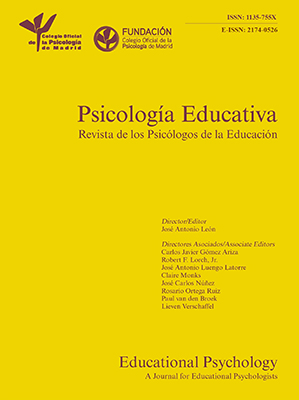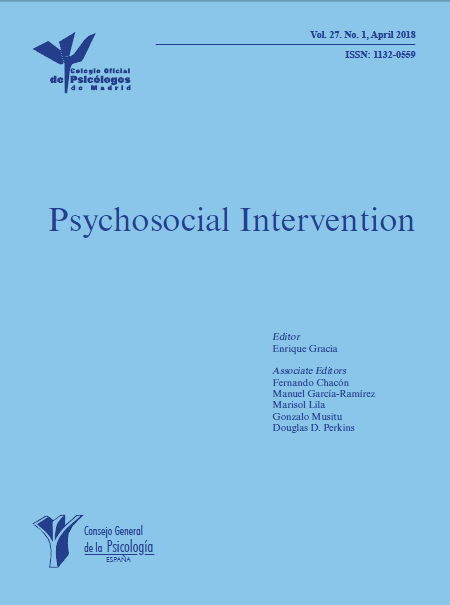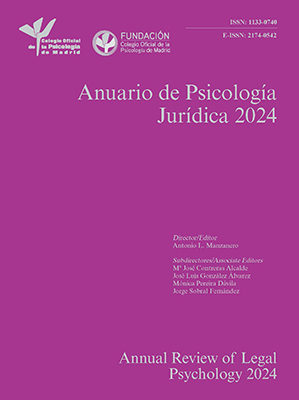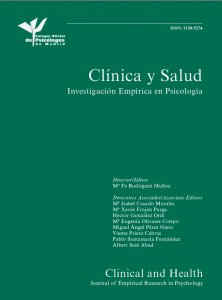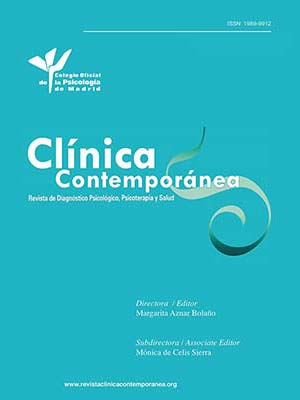
The Role of Ethical Climate in the Relationship between Task Conflict and Counterproductive Behavior
[El rol del clima Ă©tico en la relaciĂłn entre el conflicto de tareas y el comportamiento contraproductivo]
Samara Monteiro Pereira and Juliana Barreiros Porto
University of Brasilia, Brazil
https://doi.org/10.5093/jwop2025a2
Received 11 September 2024, Accepted 10 March 2025
Abstract
Counterproductive work behaviors (CWB) threaten the well-being of organizations and their members and harm the achievement of organizational results. Thus, the objective of this study was to investigate the moderating role of ethical climate in the relationship between task conflict and CWB. A sample of 268 Brazilian workers responded to the scales of task conflict, ethical climate (benevolent, principles and rules, and independence and instrumentalism) and CWB (abuse, sabotage and production deviance, withdrawal, and theft). Hierarchical multiple regression showed that task conflict had a moderate positive correlation. Moderation was significant only to the climate of independence and instrumentalism, which became the relationship between task conflict and CWB of abuse stronger; and for the climate of principles and rules, which has become the relationship between task conflict and CWB of sabotage and deviation of production weaker. The results suggest that in a context of task conflict, climate management assumes greater relevance.
Resumen
Los comportamientos contraproductivos constituyen una amenaza para el bienestar de las organizaciones y sus miembros, menoscabando sus logros. El objetivo del estudio es investigar el papel moderador que juega el clima ético en la relación entre el conflicto de tareas y los comportamientos contraproductivos. Se utilizó una muestra de 268 trabajadores brasileños, que cumplimentaron las escalas de conflicto de tareas, clima ético (benévolo, principios y reglas e independencia, e instrumentalismo) y comportamiento contraproductivo (abuso, sabotaje y desviación de la producción, abandono y hurto). La regresión múltiple jerárquica indicaba que el conflicto de tareas tenía una correlación positiva moderada. La moderación solo era significativa en el caso del clima de independencia e instrumentalismo, que fortaleció la relación entre conflicto de tareas y el comportamiento contraproductivo de abuso, y en el clima de los principios y reglas, que debilitó la relación entre el conflicto de tareas y el comportamiento contraproductivo de sabotaje y desviación. Los resultados indican que en una situación de conflicto de tareas adquiere mayor importancia el manejo del clima.
Palabras clave
Comportamiento contraproductivo, Conflicto de tareas, Clima ético, Análisis de moderaciónKeywords
Counterproductive behavior, Task conflict, Ethical climate, Moderation analysisCite this article as: Pereira, S. M. & Porto, J. B. (2025). The Role of Ethical Climate in the Relationship between Task Conflict and Counterproductive Behavior. Journal of Work and Organizational Psychology, 41(1), 11 - 17. https://doi.org/10.5093/jwop2025a2
Correspondence: samaramp@unb.br (S. Monteiro Pereira).The performance of organizations is directly related to their employees’ performance. However, some workers, rather than performing their tasks to add value to the organization, engage in behaviors that undermine organizational success, known as counterproductive work behaviors (CWB) (Ones & Dilchert, 2013). Late arrivals, misuse of organizational resources, inappropriate comments directed at coworkers, and theft are examples of these behaviors that threaten the well-being of the organization and its members and harm performance (Gruys & Sackett, 2003; Ones & Dilchert, 2013). These behaviors can arise from stressful situations in the workplace that end up leading to a negative reaction (Spector & Fox, 2005). Interpersonal conflict related to task disagreements about the tasks being performed can be seen as one such source of social stress in the workplace, leading to negative consequences such as withdrawal behaviors (Bruk-Lee et al., 2013) and bullying (Baillien et al., 2016). However, this type of conflict is also related to positive consequences, such as an increase in creativity (De Clercq et al., 2017) and innovative behaviors in teams (Giebels et al., 2016). This contradiction in the effects of task conflicts requires further studies to identify ways to mitigate their negative effects and maximize the positive ones. Toward a management of CWB, many organizations implement policies such as codes of ethics, leadership styles, training programs, and reporting channels, contributing to an ethical work climate (Treviño et al., 2014). An ethical climate emerges as a management possibility by moderating various relationships between constructs in the organizational environment (Newman et al., 2017), and as a possibility of minimizing the of certain behaviors by providing a less conducive environment for those behaviors (Loughry & Amason, 2014). However, in a context of conflict, what role would different types of ethical climates play in the release of counterproductive behaviors, since certain types of ethical climates are related to certain types of counterproductive behaviors (Peterson, 2002). Thus, the present study aims to investigate the moderating role of the ethical climate in the relationship between task conflict and CWB. For this purpose, the prediction of task conflict and the moderating role of each type of ethical climate in the different types of CWB were analyzed. It is hoped that this study will promote a better understanding of the influence of interpersonal conflicts and the ethical climate on individuals’ counterproductive behaviors and assist in the creation of policies to reduce the occurrence of such behaviors. Counterproductive Work Behaviors (CWB) The productivity and viability of organizations depend on the performance of their employees. Every day individuals engage in behaviors that both add value and harm the achievement of organizational results (Nascimento et al., 2015; Ones & Dilchert, 2013). Job performance has become a major topic in research, and can be postulated in three dimensions: task performance, organizational citizenship behavior, and avoidance of CWB (Rotundo & Sackett, 2002). Several terms have been used to define CWB, such as deviance, antisocial behavior, delinquency, retaliation, revenge, and bullying (Fox et al., 2001). The choice for the counterproductive term in this paper is based on its definition of inappropriate, ill-timed, inconvenient behavior, i.e., one that prevents the achievement of goals and generates negative results; thus, the other terms will be used here as synonyms. CWB can be defined as a deviant behavior based on the intentional violation of organizational norms (Robinson & Bennett, 1995). They are also conceptualized as actions and behaviors that employees engage in that harm organization’s goals and well-being, and bring undesirable consequences to the organization or stakeholders (Ones & Dilchert, 2013; Spector & Fox, 2005). In this definition, any action that harms legitimate organizational interests or stakeholders, regardless of the violated norm, is counterproductive. The most widely used model for deviant behaviors is Robinson and Bennett’s (1995). This model is two-dimensional and is based on the target the behavior is directed at, organization or members, and the degree of behavior severity. This categorization based on the target of the behavior is not clearly differentiated. Some behaviors are notoriously directed at the organization or members, such as breaking an organization’s equipment or yelling at a teammate, but other behaviors can be directed at both, such as retaliation (Spector & Fox, 2005). Another model suggests a classification in five categories and considers the motivation behind this behavior release (Spector et al., 2006): 1) abuse, consisting of behavior directed at individuals that threatens them physically and psychologically with unpleasant comments or by ignoring them; 2) production deviance, referring to the purposeful incorrect performance of a task; 3) sabotage, related to the destruction of property belonging to the employer;4) theft, considered a form of aggression, but occurring less frequently and associated with taking something from the organization or from another employee; and 5) withdrawal, characterized as spending less time working than it is required, such as arriving late or taking longer breaks than allowed. The abuse category is present in the interpersonal dimension and the other categories are present in the organizational dimension. The motivation for these behaviors was described in the Spector and Fox’s (2005) stressor-emotion model, in which counterproductive behavior occurs in response to a stressful incitement from the environment that generates a negative emotion. Thus, situations perceived as stressful generate high levels of negative emotions that are more likely to result in negative responses in the workplace. However, not all individuals will respond in the same way to the same conditions. In addition to individual characteristics (Ones & Dilchert, 2013; Salgado, 2002), aspects of the context were also studied as predictors. Interpersonal conflicts, organizational restrictions, and stressful roles had a positive relationship with CWB (Bowling & Eschleman, 2010), with a higher or lower correlation depending on the type of behavior. CWB targeting people, such as abuse of others, has shown a greater correlation with interpersonal conflict (Spector & Fox, 2005). Withdrawal behaviors have been found to be more correlated with restrictions of work conditions that interfere with performance, such as inappropriate equipment and conflicting work demands (Spector et al., 2006). This demonstrates that individuals may engage in certain types of CWB depending on their context, as different sources of stress lead to different reactions. Further details of the relationship between interpersonal conflict and CWB are presented below. Task Conflict Conflict can be defined as a perception, feeling or behavior of at least one individual in opposition to another (McCarter et al., 2018). Every aspect of the organizational context that creates order and coordination of effort has the potential for conflict to occur (Kilag et al., 2024). Conflicts are unavoidable in organizations (Jehn, 1995) and have been seen as the core of the organizational strain that invariably arises when individuals need mutual interdependence and are embedded in organizational structures that attempt to constrain and control their behavior (Gelfand et al., 2008). Interpersonal conflict can be classified into two dimensions: relationship conflict and task conflict (Jehn, 1995). Relationship conflict refers to interpersonal mismatches between members that include tension, animosity, and avoidance among members within the group. Problems related to this type of conflict lead to low productivity because group members focus their efforts on resolving the interpersonal conflict or ignoring it. Task conflict, in turn, is related to disagreements between group members regarding the content of the tasks performed, and includes differences in points of view, ideas, and opinions. The relationship between task conflict and performance may depend on the type of task, its variability, the complexity of the information required to perform it or the intensity of this conflict (Jehn, 1995; Jehn et al., 2015). In routine tasks, both relationship conflict and task conflict are harmful, regardless of the level at which they are experienced, whereas in non-routine tasks moderate levels of task conflict have a positive effect on team performance. There is evidence that task conflict had a curvilinear effect on team performance in teams with high expertise disparity, and linear in teams with low expertise disparity (Lee et al., 2022). This positive effect was found in innovative behaviors (Giebels et al., 2016; Posthuma et al., 2011), job performance (Chun & Choi, 2014; Lee et al., 2015), and creativity (De Clercq et al., 2017; Fairchild & Hunter, 2014). However, other studies demonstrate the negative effects of this conflict, where both task and relationship conflicts had a negative correlation with team performance (De Dreu & Weingart, 2003). Despite the possibility that certain types of conflict are positive at a low level of intensity, this effect decreases as the conflict increases, impairing cognitive processing to coping and leading to team distress. Among the negative effects of task conflict, aggressive bullying behavior has been positively associated with this type of conflict, so that the higher the levels of task conflict, the more bullying behaviors are witnessed (Ayoko et al., 2003; Baillien et al., 2016). Thus, conflict is a prevailing source of social stress in the workplace (Bruk-Lee & Spector, 2006) and has a direct relationship with CWB (Kessler et al., 2013). This study suggests a model wherein task conflict between group members is directly related to CWB. Hypothesis 1: Task conflict shows a positive relationship with CWB. Ethical Climate Individuals look for clues in their environment about the most appropriate conduct for that context. According to the social information processing theory, people adapt their attitudes and behaviors to their social context according to the social information obtained from that environment (Salancik & Pfeffer, 1978). Thus, the organizational environment becomes an important source of information about which conduct is acceptable in that context (Decoster et al., 2019). This environment can hinder or promote behavior, even in the presence of other antecedent variables. The perception of members of a group regarding ethically correct behaviors and ethical decision-making in a given work context is defined as the ethical climate (Martin & Cullen, 2006; Victor & Cullen 1988). The ethical climate is the result of policies, practices, and leadership, and has a significant influence on the ethical decision-making of members and their subsequent behaviors (Newman et al., 2017; Schminke et al., 2007). An ethical climate is an important filter through which employees understand what their work unit is like regarding ethical issues (Decoster et al., 2019). As it reflects the prevailing ethical values and norms of the members of a social context, a strong ethical climate is related to positive outcomes, such as satisfaction and commitment, and a weak ethical climate is related to negative results, such as turnover intentions and unethical behavior (Arnaud, 2010; Decoster et al., 2019). The most widely used theoretical model classifies the ethical climate in the dimensions of benevolence, selfishness, and principles. This model includes three loci of analysis (individual, local, and global), which results in nine types of ethical climate based on a matrix that includes those dimensions (Victor & Cullen, 1988). However, most research has substantiated the existence of only five types: instrumental climate, caring, independence, laws and codes, and rules (Newman et al., 2017). In the Brazilian context, such dimensions were found, but with a different format. The climates of benevolence, principles and rules, and independence and instrumental were identified (Ribeiro et al., 2016). These climates refer, respectively, to the interest in workers’ well-being, adherence to organizational norms and policies, and focus on individual decisions to establish what is right or wrong. The ethical climate has been shown to have a significant negative influence on deviant behavior in the workplace (Aryati et al., 2018). However, different types of ethical climate lead to different consequences (Newman et al., 2017; Peterson, 2002). Among the five proposed climates, it has been argued that the caring climate, the rule climate, and the instrumental climate would be the most related to the CWB (Vardi, 2001; Wimbush et al., 1997). In a caring climate, individuals are interested in the well-being of others and in the rule climate, employees strictly follow the rule of their organization. Both types of climate are then expected to motivate employees to have “good” behaviors and to be disciplined to produce an environment that weakens engagement in unethical behavior. Within an instrumental climate, the focus is on an individual’s self-interest, and because it is based on making selfish decisions, regardless of the rules or the possible impact of their actions on others, this type of climate can promote an environment conducive to engagement in unethical behaviors (Victor & Cullen, 1988; Chen et al., 2013). A caring climate was also found to reduce the likelihood of encountering favoritism, gossip, and accusation behaviors from co-workers. A climate of encouraging adherence to laws and rules is related to a reduction in behaviors regarding the misuse of organizational resources. Production deviance behaviors are more likely to be minimized with a caring and independent climate and encouraged with an instrumental climate, where members care about themselves (Peterson, 2002). In this same line, other studies have suggested that caring, law and code, and rule and independence climates reduce inappropriate behaviors in the organization, such as theft and sabotage, contrasting to the negative effects arising from perceptions of instrumental ethical climates (Martin & Cullen, 2006). Results on the moderating role of ethical climate between negative affections and deviant behaviors bring different findings regarding the caring climate (Chen et al., 2013). Results were found that reveal that the stronger the rule climate, the weaker the relationship between negative affections and deviant behaviors and that the stronger the instrumental and caring climate, the stronger the relationship between negative affections and deviant behaviors. Newman et al. (2017) reported other findings, showing that the caring climate had a positive relationship with organizational commitment and job satisfaction. The instrumental climate had a negative relationship with both variables. The independence and rule climates had a positive relationship with ethical behavior. The rule climate and the law and code climate had a positive relationship with performance. Concerning dysfunctional behaviors, they showed that bullying had a negative relationship with the rule climate, but a positive relationship with the instrumental climate (Newman et al., 2017). Therefore, the instrumental climate is considered a negative type of ethical climate because it is related to self-interest, while the other types of climate are considered positive. These promote positive organizational attitudes, concern for the well-being of others, compliance with laws or organizational policies and procedures, and adherence to personal ethical beliefs (Chernyak-Hai & Tziner, 2014). Thus, in light of the influence of different types of ethical climate on individuals’ behaviors, it was expected that climate could influence the relationship between conflict and CWB by creating a context that signals for expected behaviors when conflict situations occur. Hypothesis 2a: The ethical climate of independence and instrumentalism moderates the relationship between task conflict and CWB in such a way that individuals who report a higher score in task conflict also report higher score in CWB when they perceive higher levels of an ethical climate of independence and instrumentalism. Hypothesis 2b: The ethical climates of benevolence and principles and rules moderate the relationship between task conflict and CWB in such a way that individuals who report a higher score in task conflict report lower score in CWB when they perceive higher levels of an ethical climate of benevolence and principles and rules. Participants Data were collected from a total of 268 Brazilian workers. After removing 45 extreme cases, by calculating the Mahalanobis distance (Tabachnick & Fidell, 2001), the sample of valid respondents consisted of 223 participants. The sample was characterized by a predominance of women (63%), with a mean age of 32 years (SD = 10.3), completed post-graduate studies (Specialization, Master’s, and PhD) (44%), working in public organizations (63%), and who had taken part of the team for over a year (77%). Measures All study variables were collected by means of scales applied to individuals, with the team as referent. MTask Conflict Escala de Conflitos Intragrupos - ECIG [Intragroup Conflict Scale] (Silva & Puente-Palacios, 2010). The measure consists of 11 items that describe disagreements or tensions in the group. The items are answered on a 5-point Likert scale, ranging from 1 (none) to 5 (very much). The measure has an internal structure organized into two factors, relationship conflict and task conflict, but only the second factor was used (5 items; α = .86, item-total r = .68; e.g., ‘How much difference of opinion about task planning is there in the group?’). Ethical Climate Escala de Clima Ético nas Organizações [Scale of Ethical Climate in Organizations] (Ribeiro et al. (2016). The measure consists of 19 items that describe an organization’s pattern of behavior regarding the interest in workers’ well-being, workers’ adherence to organizational norms, and whether it emphasizes individuality as a characteristic of organizational policies. The items are answered on a 6-point true/false Likert-type scale, with extremes ranging from 1 (completely false) to 6 (completely true). The measure has an internal structure organized into three factors, the first being Benevolence (7 items; α = .95, item-total r = .82; e.g., ‘Our greatest concern is the well-being of everyone who works in this company’), the second factor, Principles and Rules (6 items; α = .92; item-total r = .78; e.g., ‘It is very important to strictly follow the rules and procedures of the organization’), and the third factor, Independence and Instrumentalism (4 items; α = .83; item-total r = .66; e.g., ‘What matters in this organization is what each one considers right or wrong’). Two items from the Benevolence factor of the original scale were excluded because they loaded on a different factor from the original scale, that of Principles and Rules (Items: ‘People in this company have a strong sense of responsibility to the local community’ and ‘Each person is expected to be treated well when decisions are made’). Counterproductive Work Behavior The translation of the Counterproductive Work Behaviors Checklist scale by Spector et al. (2006) was used. The original measure consists of 33 items that provide examples of counterproductive behaviors. The items are answered on a 5-point Likert frequency scale, ranging from 1 (never) to 5 (every day). The measure has an internal structure organized into five factors. The first is about Sabotage (3 items; α = .76; e.g., ‘Purposely wasted your employer’s materials/supplies’); the second on Withdrawal (4 items; α = .80; e.g., ‘Stayed home from work and said you were sick when you were not’), the third on Production Deviance (3 items; α = .66; e.g., ‘Purposely did your work incorrectly’), the fourth on Theft (5 items; α = .82; e.g., ‘Took supplies or tools home without permission’), and the fifth on Abuse (18 items; α = .91; e.g., ‘Being nasty or rude to a customer’). This scale was translated according to the guidelines for translation and test adaptation (Muñiz et al., 2013), with a translation from English into Portuguese and a reverse translation with the back-translation method, in addition to a semantic analysis performed by judges. The translated scale was applied following the instruction of the original scale. Procedure The questionnaire was applied via Jotformz electronic form from August to October 2019. The questionnaire was disseminated in email lists and social networks by the snowball technique, where the initial participants of a study suggest new participants, who in turn suggest new participants, and so on. The scales were applied following the order in which they were described in the previous section. The orientation was that the participant should be working and that s/he should answer the items referring to his/her work team. Participants were volunteers who were invited to sign the Free and Informed Consent Form (FICF) and assured of the confidentiality of responses and identity. Data Analysis The analysis of statistical assumptions was performed in the SPSS, version 25. We identified 14 pieces of missing data (0.05%), which were replaced by the mean of the items. After data treatment, an exploratory factor analysis of the scales was performed, based on the Kaiser-Mayer-Olkin (KMO) criterion and Bartlett’s test of sphericity. The KMO shows how much of the items’ variance proportion can be explained by a latent variable; in this case, values of above .70 will be considered. Bartlett’s test of sphericity evaluates to what extent the (co)variance matrix is similar to an identity matrix, where significant values (p < .05) suggest that the matrix is factorable. With this, the number of factors for all scales was analyzed as a function of the principal axis factoring (PAF) method and Promax rotation. Coefficients smaller than .30 were removed (Tabachnick & Fidell, 2001). Items that had factor loadings greater than .30 on more than one factor and with a difference less than .10, and that had an acceptable factor loading on the factor not corresponding to the theoretical model were also removed. The reliability of the factor structure was calculated by Cronbach’s alpha. The hypotheses were verified from Pearson’s correlation analysis and hierarchical multiple regression by the insert method. Previously, normality was checked and the effect size was calculated. The independent variable and each factor of the moderator variable were centered and two three-step regression models were created. For the first model, the independent variable (task conflict) was entered with the moderator variable (ethical climate), and for the second model the multiplication of both was entered. In each step, the regression was run with each type of ethical climate separately. The moderating role of ethical climate was analyzed by the Process program. The Kolmogorov-Smirnov and Shapiro Wilk normality tests were significant, which does not attest to the normality of the distribution. However, the data are within the 95% confidence interval, which suggests that the sample is within the population mean and that the distribution tends to have a normal shape (Dancey & Reidy, 2018). Thus, one can proceed with the further statistical analyses. Factor analysis of the CWB scale showed a possibility of extracting up to eight factors. In previous studies the items were grouped into five factors (Bruursema et al., 2011; Palmer et al., 2017). Thus, uniqueness of the criteria was not observed and a five-factor solution was chosen, following the literature. After removing nine items which scored lower than .30, the model with four factors was arrived at, which retained all items with factor loadings greater than .33. Bartlett’s test of sphericity was significant (χ2 = 2044.713, p < .00) and the KMO was .84. The final scale has 24 items and an explained variance of 51.7%. The first factor was Abuse, with eleven items (α = .85, item-total r = .56); the second factor was Withdrawal, with four items (α = .80, item-total r = .62); the third factor was Sabotage and Production Deviance, with six items (α = .72, item-total r = .48); and the fourth factor was Theft, with three items (α = .53, item-total r = .41). Table 1 Descriptive Statistics and Correlations among Constructs   Note. Conflict = task conflict; Benevolence = benevolence climate; Principles = principles and rules climate; Independence = independence and individualism climate; Abuse = counterproductive abuse behavior; SabDP = counterproductive sabotage and production deviance behavior; Withdrawal = counterproductive withdrawal behavior; Theft = counterproductive theft behavior. *p < .05, **p < .01. Table 2 Hierarchical Multiple Regressions for Each Type of Counterproductive Work Behavior (CWB)   Note. Conflict = task conflict; Benevolence = benevolence climate; Principles = principles and rules climate; Independence = independence and individualism climate; Abuse CWB = counterproductive work behavior of abuse; SabPD CVW = counterproductive work behavior of sabotage and production deviance; Withdrawal CWB = counterproductive work behavior of withdrawal; Theft CWB = counterproductive work behavior of theft. *p < .05, **p < .01. The descriptive analysis (Table 1) showed low perceived CWB in the team, with a higher mean for withdrawal CWB and a lower mean for theft CWB. Task conflict was perceived as low to moderate, being close to the midpoint of the scale. The ethical climate, on the other hand, obtained the highest averages, in which the ethical climate of rules and principles obtained the highest and the ethical climate of independence and instrumentalism the lowest average. The correlations between task conflict and the four factors of CWB varied in size, ranging from weak to moderate, and all with significant positive associations, which supports Hypothesis 1. CWB of abuse and withdrawal were found to have stronger relationships with task conflict than CWB of theft and sabotage and production deviance. The correlation analyses between ethical climate and CWB also varied in reference to the sign of the relationship, where only a few correlations were significant. The results showed that the higher the benevolence climate, the lower the CWB of abuse, withdrawal, and theft. They also showed that the higher the rules and principles climate, the lower the engagement in CWB of abuse, withdrawal, and sabotage and production deviance. And finally, they showed that the greater the climate of independence and individuality, the greater the emission of CWB of withdrawal. After verifying the relationships between the variables, hierarchical multiple regression was performed to verify whether task conflict and the three types of ethical climate were able to predict CWB (Table 2). The regression indicated that task conflict explained 17.1% of Abuse CWB, F(1, 221) = 45.631, p < .001, 16.6% of Withdrawal CWB, F(1, 221) = 44.079, p < .001, 8.7% of Sabotage and Production Deviance CWB, F(1, 221) = 21.130, p < .001, and 2.8% of Theft CWB, F(1, 221) = 7.387, p < .01. For Abuse CWB, the climate of Independence and Individuality was the only factor that showed significance in moderation (β = .194, t = 3.23, p = .001). The interaction between Task Conflict and the Independence and Individuality climate proved to be a statistically significant model for the Abuse CWB, F(3, 219) = 19.730, p < .001, R² = .202. For the Sabotage and Productive Deviance CWB, the climate of Principles and Rules was the only factor that showed significance in moderation (β = -.131, t = -1.95, p = .05), compared to the climate of Benevolence (β = .053, t = .79, p = .43) and Independence and Individualism (β = .102, t = 1.58, p = .11). The interaction between task conflict and a climate of Principles and Rules presented as a statistically significant model for Sabotage and Production Deviance CWB, F(3, 219) = 9.655, p < .001, R² = .117. For the significant moderations, the Process program suggested that the higher the climate of Independence and Individualism, the higher the Abuse CWB (Figure 1), which supports Hypothesis 2a. In this regard, the Independence and Individualism climate strengthened the relationship between Task Conflict and Abuse CWB. The program also indicated that the higher the Rules and Principles climate, the lower the Sabotage and Production Deviance CWB (Figure 2). That is, the climate of Principles and Rules weakened the relationship between Task Conflict and Sabotage and Production Deviance CWB. Since no significant moderation of the Benevolence climate was found between Task Conflict and CWB, Hypothesis 2b was partially corroborated. Figure 1 The Moderating Role of Independence and Individualism Climate in the Relationship between Task Conflict and the CWB of Abuse.  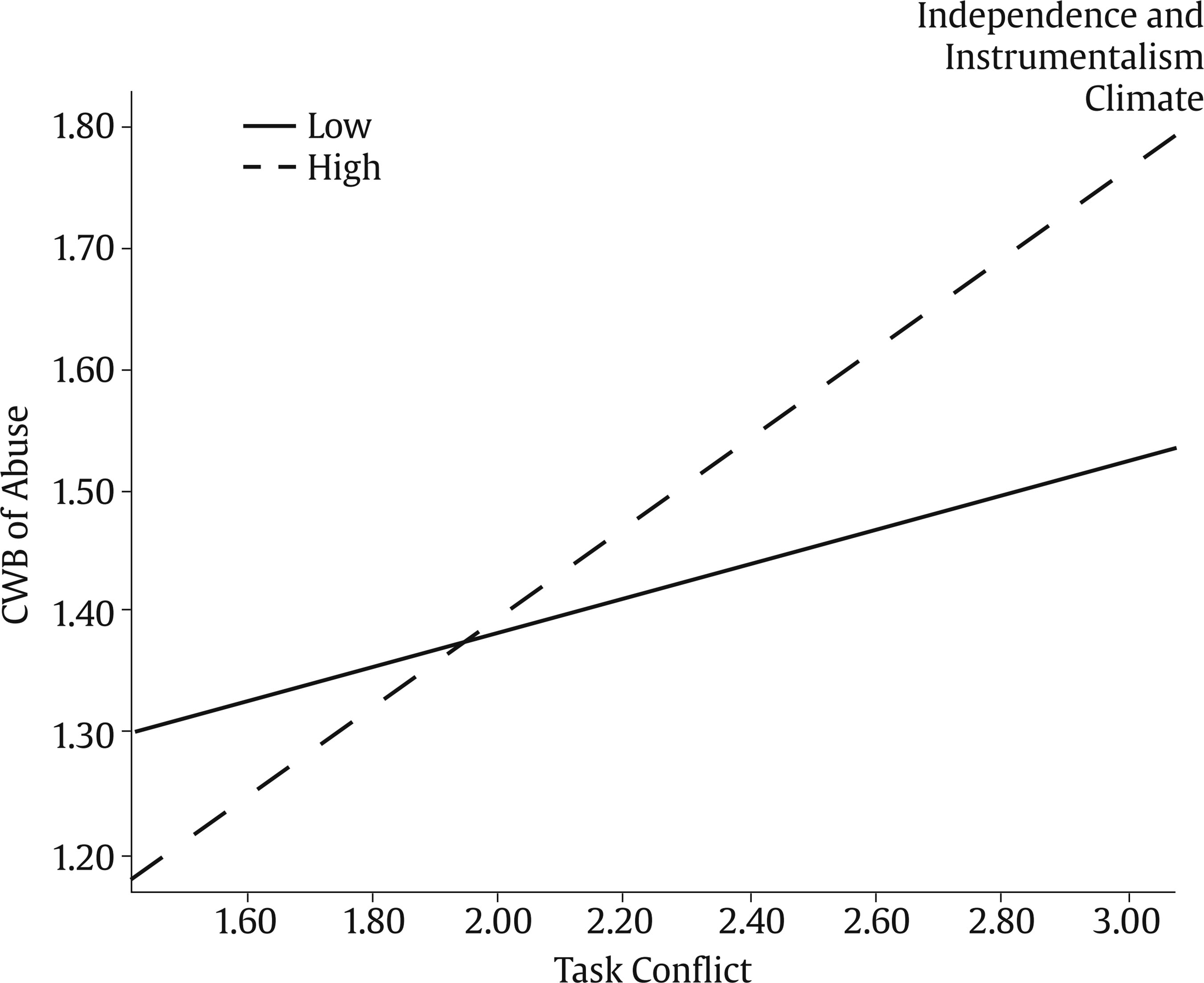 Figure 2 The moderating role of the Principles and Rules Climate in the Relationship between Task Conflict and the CWB of Sabotage and Production Deviance.  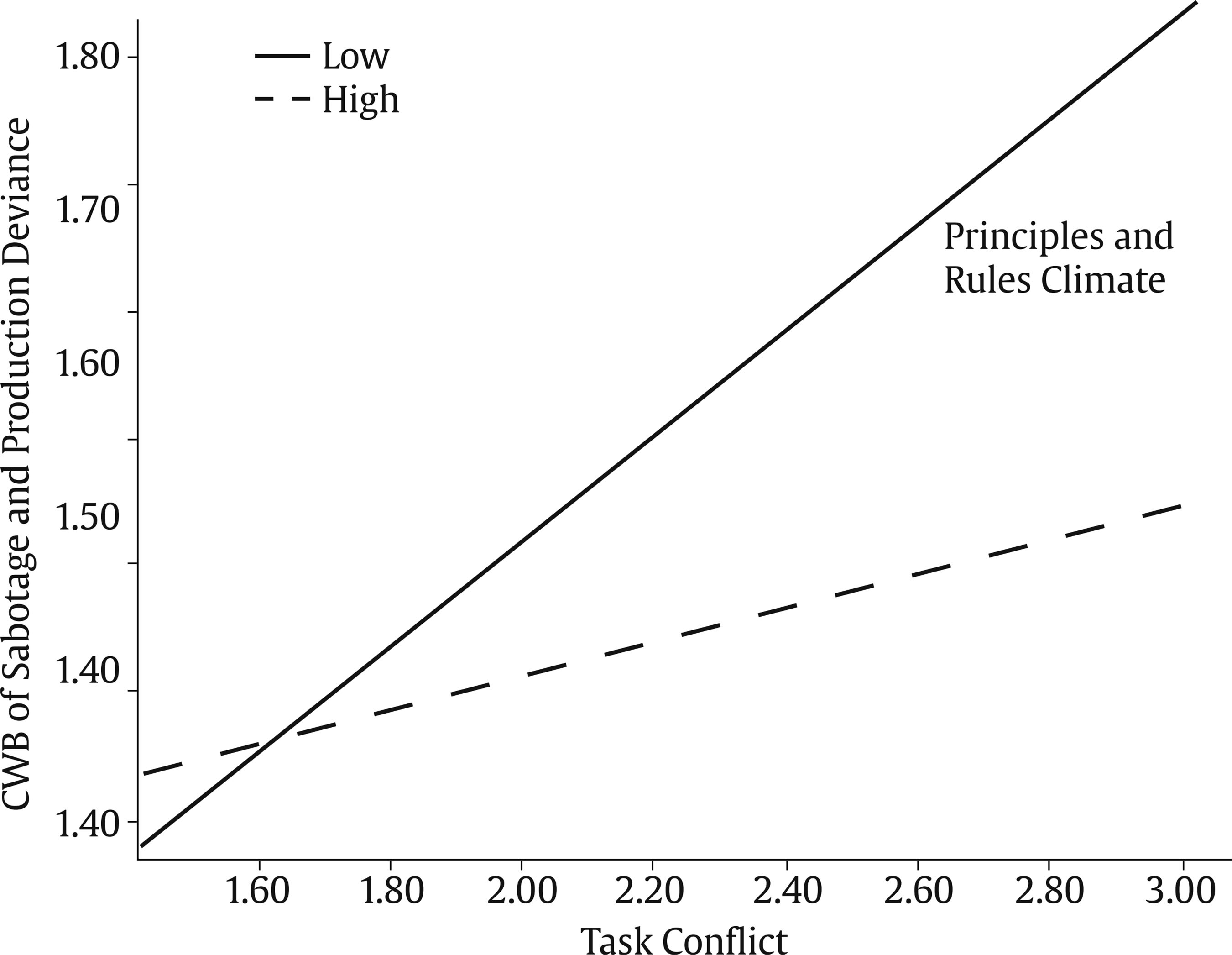 The initial question was asked about the relationship between task conflict and CWB at work, and how different types of ethical climate act on the relationship between these two variables. The answers were obtained from questionnaires and regression analysis. The results provide support for Hypothesis 1 of the research and show that task conflict has a direct positive relationship with CWB and explained between 2 and 16% of the variation in this behavior. It can be concluded that not only relationship conflict predicts deviant behavior, but also task conflicts (De Dreu & Weingart, 2003). Furthermore, task conflict had a higher predictive power for abuse and withdrawal CWB, which shows that differences of opinion regarding task performance more strongly predict CWB directed toward colleagues and work avoidance. This result corroborates with the literature in the field (Bruk-Lee et al., 2013), although interpersonal CWB showed a stronger correlation with interpersonal relationship conflict (Spector & Fox, 2005). In this respect, disagreement on opinions regarding tasks can also be perceived as personal incompatibility. The instrumental climate brings negative consequences to the work environment, in which the greater this type of climate, the greater the engagement in deviant behavior at work, unlike the climate of independence (Chen et al., 2013; Leung, 2008; Martin & Cullen, 2006; Wimbush et al., 1997). In the present study, instrumental climate and independence climate formed the same factor, which made it impossible to analyze the effects of each separately. Results pointed out that instrumental and independence climate positively affect withdrawal CWB weakly, and in the regression this effect is not significant when considering all climate factors together. The fact that the two types of climate did not differ in the sample may have canceled out the contradictory effects, not showing the expected relationship. Further studies should propose modifications to the scale in order to differentiate these two factors and test them again. However, in the present study, there was a significant positive relationship of the two climate types with withdrawal. Thus, the higher the ethical climate focused on the individual himself, the higher the CWB of withdrawal. This relationship was not found in this research, although the instrumental climate has a relationship with CWB of production deviance (Peterson, 2002). Furthermore, a significant moderation of the independence and instrumentalism climate was found in the relationship between task conflict and abuse, so as to strengthen this relationship. This moderation supports Hypothesis 2a and demonstrates that with differences of opinion regarding tasks, a climate in which everyone defines right and wrong and is self-focused stimulates counterproductive reactions to interpersonal disagreements. Therefore, in a context of task conflict, the climate of independence and instrumentality must be attenuated in order to reduce the CWB of abuse. A climate based on adherence and obedience to rules and codes of conduct is positive in that it promotes the emergence of organizational attitudes, so that laws and organizational policies and procedures are followed (Leung, 2008; Martin & Cullen, 2006; Peterson, 2002; Wimbush et al., 1997). A similar result was found in the present research, where the climate of rules and principles showed negative relationship with CWB of abuse, sabotage, production deviance, and withdrawal. This climate type significantly moderated the relationship between task conflict and CWB of sabotage and production deviance. The greater the climate of rules and principles, the weaker the relationship presented. This result brings partial support to Hypothesis 2b. Therefore, in a context of differences of opinion regarding the tasks to be performed, a climate that encourages obedience to rules and codes of conduct should be encouraged, as it minimizes misuse of organizational resources and production deviance. The ethical climate of benevolence showed a significant negative relationship with CWB of abuse, withdrawal, and theft. This result is supported by other findings, in which the benevolence climate is positive for the work context in that it promotes the emergence of positive organizational attitudes, such as concern for the well-being of others (Leung, 2008; Martin & Cullen, 2006; Peterson, 2002; Wimbush et al., 1997). Despite this, no evidence was found on its moderation in the relationship between task conflict and CWB, which does not support Hypothesis 2b. The present study uses the individuals’ perception of CWB in the team as a procedure to access these behaviors, due to the difficulty of measuring these behaviors through self-report. This method is an alternative to decrease the social desirability present in these types of behaviors. The measurement of the other two variables, ethical climate and task conflict, was also performed using the individuals’ perception of these phenomena. Despite the criticism of studies that evaluate phenomena using the perception of individuals, in the present study this procedure did not harm its theoretical, methodological, and practical contribution, because individuals' behavior is influenced both by the actual treatment they receive and the interpretation of that treatment (Salancik & Pfeffer, 1978). However, a limitation of the study is that the predictive power of the regression model was assessed using R², which may overestimate the explained variance. Although the multiple correlation coefficient provides an indicator of the explained variance, it is susceptible to overfitting, particularly in smaller samples. A cross-validated squared multiple correlation, as proposed by Browne (1975), could provide a less biased estimate of the model’s predictive ability. Future studies may consider including this statistical adjustment to enhance the robustness of regression analyses and better evaluate the generalizability of the findings. Future studies should investigate the variables present here in order to aggregate them to their level of analysis – the team – to verify possible convergences and divergences in the findings. The results presented here indicate that the ethical climate did not moderate all the relationships analyzed. In this regard, other contextual variables should be investigated to verify ways to reduce the negative impacts of CWB. Also, a measure of social desirability should be included in studies on CWB, regardless of the referent, since it is a variable that is present in the reports of these behaviors. CWB is a complex and difficult-to-measure phenomenon, either by self- or hetero-report, because it is a behavior generally inversely associated with social desirability. Therefore, the present research contributes to studies in the area by using an alternative method of measurement and expanding the understanding of the background of CWB. It also provides evidence on the way individuals’ perceptions of their work context influence their behavior. Finally, it contributes to professional practice by pointing at interventions that have the potential to reduce the negative effects of conflict. Conflict is a phenomenon inherent in an environment of social interaction and ethical climate management allows for minimizing the negative effects of interpersonal disagreements in the work environment. Conclusion The present study found evidence that task conflict has a positive relationship with CWB at different intensities, depending on the type of behavior emitted, and that not all ethical climates have a positive influence on the behavior of employees. These findings indicate the need to research these constructs by considering the factors that make them up, rather than from an overall aspect of the variable. Therefore, it is possible to assess each aspect of the phenomenon separately and a more directive and effective management becomes possible, providing different perspectives to be adopted depending on the employees’ behaviors. Evidence was also found that encouraging adherence to organizational norms and policies can minimize engagement in behaviors aimed at poor task performance and damage to company property in a context of interpersonal conflicts over tasks. Such an adherence to organizational norms and policies can be encouraged based on leadership that follows the rules and conduct of the organization by a fair system of rewards and punishments, and encouragement of practices based on organizational principles. Thus, even if there is a perception that interpersonal conflicts exist in the team, management can minimize the negative effects on the behavior of employees, with interventions based on adherence to organizational rules and principles. Conflict of Interest The authors of this article declare no conflict of interest. Cite this article as: Monteiro Pereira, S., & Barreiros Porto, J. (2025). The role of ethical climate in the relationship between task conflict and counterproductive behavior. Journal of Work and Organizational Psychology, 41(1), 11-18. https://doi.org/10.5093/jwop2025a2 References |
Cite this article as: Pereira, S. M. & Porto, J. B. (2025). The Role of Ethical Climate in the Relationship between Task Conflict and Counterproductive Behavior. Journal of Work and Organizational Psychology, 41(1), 11 - 17. https://doi.org/10.5093/jwop2025a2
Correspondence: samaramp@unb.br (S. Monteiro Pereira).Copyright © 2025. Colegio Oficial de la Psicología de Madrid








 e-PUB
e-PUB CrossRef
CrossRef JATS
JATS
